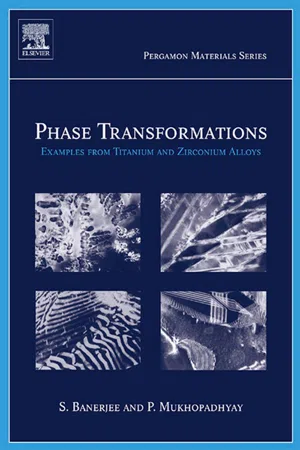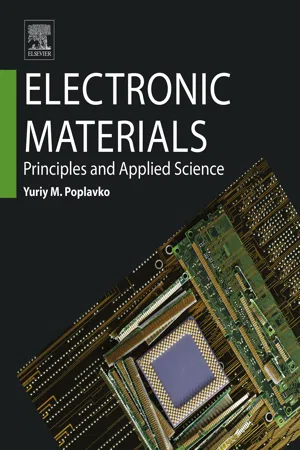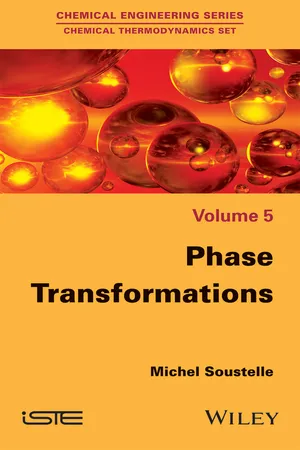Technology & Engineering
Phase Transformations
Phase transformations refer to the changes in the structure of a material as it transitions from one phase to another, such as from solid to liquid or from one crystal structure to another. These transformations can significantly impact the mechanical, thermal, and electrical properties of materials, making them a crucial consideration in the design and processing of engineering materials.
Written by Perlego with AI-assistance
Related key terms
Related key terms
1 of 4
Related key terms
1 of 3
4 Key excerpts on "Phase Transformations"
- eBook - ePub
Phase Transformations
Examples from Titanium and Zirconium Alloys
- Srikumar Banerjee, Pradip Mukhopadhyay(Authors)
- 2010(Publication Date)
- Elsevier Science(Publisher)
Phase Transformations also occur in organic materials such as polymers, biological systems and liquid crystals. Many of the relevant concepts developed for inorganic systems have parallels in organic systems. However, no attempt will be made in this chapter to compare and contrast Phase Transformations in organic and inorganic systems as the nature of atomic interactions responsible for the transformations is quite different in these two classes of materials. Alloys, intermetallics and ceramics form a group of materials in which Phase Transformations can be discussed on a common conceptual basis and, therefore, a single classification scheme can be used for appropriately grouping different types of transformations in these systems. As mentioned earlier, Ti- and Zr-based systems, which include alloys, intermetallics and ceramics, exhibit nearly all possible types of Phase Transformations and, therefore, serve as excellent examples for studies on Phase Transformations in inorganic materials in general.Phase Transformations can be classified on the basis of different criteria, namely, thermodynamic, kinetic and mechanistic (Christian 1965 , Roy 1973 , Rao and Rao 1978 ). A comparison of the characteristic features of different types of transformations is presented in this chapter with a view to providing a coarse-brush picture of these in a generalized manner. The chapters which follow will describe these transformations more elaborately, taking illustrative examples from Ti- and Zr-based systems.2.2 Basic Definitions
In order to resolve some of the confusion and controversy which are of a semantic nature a summary of some basic definitions is presented here.A phase - eBook - ePub
Electronic Materials
Principles and Applied Science
- Yuriy M. Poplavko(Author)
- 2018(Publication Date)
- Elsevier(Publisher)
gas ⇔ liquid ⇔ solid ” phases.However, in many technical applications of solid materials , primary importance is given to another type of PTs that occur inside the solid state or inside the liquid state without changing the aggregate state. These conversions take place because of the interactions of matter's structural elements: electrons, ions, dipoles, and molecules (or their complexes).The question is that near PT the structure of a matter is extremely sensitive to any external influences (thermal, electrical, magnetic, or mechanical); even in case of minor changes of T , E , H , or X , electrical, magnetic, optical, and other properties of substance demonstrate considerable variations. This unusually high sensitivity near the PT even to weak external influences is used in many devices and equipment of electronics and instrumentation [1] .Usually, in the event of a change in external conditions, main electrical properties of crystals (conductivity, permittivity, permeability, optical activity, and others) change smoothly . However, near the PT these parameters vary essentially, even by a jump , sometimes, in several orders of magnitude. This means significant modification in the crystal properties [2] .Provoked by external influence, PTs in the magnets, metals, dielectrics, and semiconductors are accompanied by substantial restructuring of material subsystems: electronic, phonon, dipole, magnetic, or others. This restructuring is obviously accompanied by a change in crystal symmetry in the vicinity of PT. For instance, in the polymers different PTs are determined by the peculiarities of their intermolecular interactions: vitrifying, orientation melting, crystallization, and so on. Another example is the liquid crystals (LCs), where PTs are conditioned by the appearance (or change) of linear, planar, or helical ordering of anisometric molecules. - eBook - ePub
- Michel Soustelle(Author)
- 2016(Publication Date)
- Wiley-ISTE(Publisher)
1 Phase Transformations of Pure SubstancesIn this chapter we shall examine the transformations undergone by a definite pure compound, with no chemical alteration. These transformations belong to the category of phase transitions, or Phase Transformations. Hence, this chapter excludes the transformations of isomerization and decompositions which are accompanied by a chemical alteration – i.e. a modification of the molecule.1.1. Standard state: standard conditions of a transformation
The “standard state” of a substance at temperature T is defined as the state of the pure substance at that temperature, at a pressure of 1 bar and as its stable state of aggregation in these conditions (solid, liquid or gas). If the substance is a gas, its behavior is perfect. If the pure substance is a crystalline solid, its stable state of aggregation determines the crystalline system. A transformation takes place in standard conditions if it occurs with the components in their standard state in the final state. This means that at the start of the reaction, the substance is in a non-standard state, which is unstable, and that it returns to its stable standard state at the end. Thus, only the state of aggregation may possibly have been modified by the transformation. This is indeed a phase transformation, in that the state of aggregation defines a phase.1.2. Classification and general properties of Phase Transformations
Phase transitions are classified into different types. The advantage of classifying definite compound transformations depending on their order lies in the fact that a series of relations characterizes each order.The first classification of these transitions is attributable to Ehrenfest, in which we say that a transformation is of order n when at least an nth derivative of the characteristic function in relation to its canonical variables undergoes a discontinuity for certain values of those variables, when the derivatives of order less than n - David R. Gaskell, Matthew John M. Krane(Authors)
- 2024(Publication Date)
- CRC Press(Publisher)
Other examples are described in the next section.) The transport phenomena (along with the phase equilibria in the material) are the mechanisms that produce many material properties throughout processing by the control of microstructure development. This interrelationship is illustrated by the oft-cited “MSE triangle” shown in Figure 1.1. The three vertices of this triangle are interdependent, and understanding the physical mechanisms of transport phenomena is necessary to understanding many of these relationships. The primary approach we will use here to improve our understanding and our predictions is the making of models of the transport phenomena. These models are mathematical representations of reality, not reality itself. In an excellent description of model-making methodology in materials science and engineering, Ashby [ 2 ] wrote: A model is an idealization. . . (it) unashamedly distort(s) the inessentials in order to capture the features that really matter. . .
Index pages curate the most relevant extracts from our library of academic textbooks. They’ve been created using an in-house natural language model (NLM), each adding context and meaning to key research topics.
Explore more topic indexes
Explore more topic indexes
1 of 6
Explore more topic indexes
1 of 4



